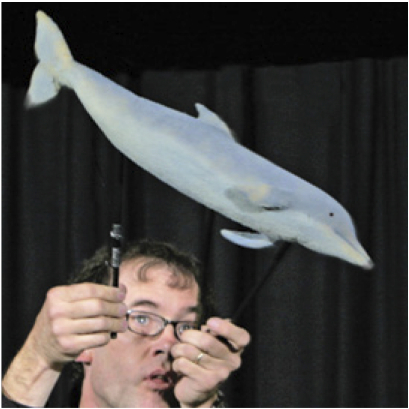MATERIALS: THE STUFF OF PUPPETRY
SPRING/SUMMER 2016 ISSUE NO. 39
Table of Contents • Editor's Note • Selections
Carved Foam Rubber Puppets
by Hobey Ford
Foam rubber is almost everywhere in the puppetry world, thanks to its lightweight and flexible nature. I am here to talk about carved foam puppets and their unique quality of movement. Foam rubber, or polyurethane foam, has been used as a puppetmaking medium for over fifty years. Sheet foam achieved fame among puppeteers through the Muppets, but Arlyn and Luman Coad were the first to carve blocks of foam into puppets in the 1960s. I use very soft, medium density foam rubber. Most of my carving is done with an electric meat knife and scissors. The beauty of foam is that once you carve a creature, all the movement is built into the medium; every cell of the foam is in motion.
The foam’s flexibility indeed sometimes has to be limited with armatures serving as bones in the structure. Through manual manipulation, faces can be made to grimace, shapes to transform or even turn inside out. Most people approaching carved foam want to cover it, as it is delicate and easily damaged. Covering the foam is the very thing you don’t want to do if you want to exploit its movement qualities. I have used the foam to create the illusion of creating a clay pot by squeezing and holding the carved clay bowl as if it is a ball of clay and, while miming the shaping of the clay, slowly releasing the bowl, allowing it to come back to its original shape. The effect is simple to manipulate but uncanny to the observer. I manipulate carved foam puppet figures with rods, hands or sometimes—as with carved faces—from within.
Very few puppeteers have utilized carved polyfoam. Jordi Bertran from Barcelona, while not using carved foam, gets foam’s lovely movement qualities, making a very human character out of a few snippets of foam. Up and coming group Poncili Creación from Puerto Rico create all their puppets from carved foam, manipulating it directly with their hands. With carved foam puppets, the main event is the overall movement of the figure, which allows a kind of animation not possible with other mediums.
Hobey Ford’s Golden Rod Puppets have delighted audiences since 1980. He is the creator of Peepers Puppets and is a Kennedy Center teaching artist.






